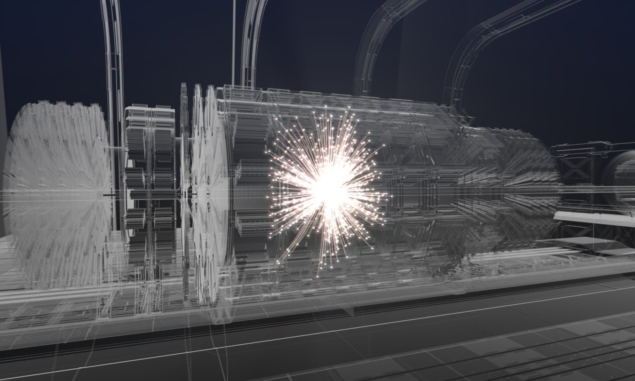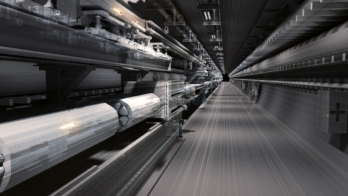
The next major European project after the LHC should be a 100-km circumference circular collider, argue more than 50 senior particle physicists in a preprint posted on arXiv at the end of last year. The authors — who include two previous CERN Council presidents, two former CERN Directors-General, leading members of the LHC experiments and high-energy theorists – say that the sequential electron-positron and hadron-hadron programme of the CERN-led Future Circular Collider (FCC) offers the most promising way to explore in full detail the Higgs sector and extend substantially the reach for new physics, and is the best option to maintain Europe’s place at the high-energy frontier during the coming decades.
“The combination of FCC-ee and FCC-hh will provide a forefront scientific programme for CERN for many decades, just as the combination of LEP and LHC has done,” says coauthor and former CERN Council president Michel Spiro. “We consider FCC to be a visionary programme for the future of CERN.”
“We consider FCC to be a visionary programme for the future of CERN”
The 15-page long preprint comes as the update of the European strategy for particle physics enters its final stages, and notes that several important new facts have emerged during the past year: the FCC conceptual design reports were published in January; in March, Japan postponed the decision about an International Linear Collider to an indefinite date; in May, Europe discussed its particle physics strategy at an open symposium in Granada, where several high-energy options were presented; and in September, the European Strategy Group (ESG) published a Physics Briefing Book and prepared a supporting note which included five possible scenarios for major new accelerator facilities and raised a number of important issues. In Europe the options for a post-LHC collider are the FCC and Compact Linear Collider (CLIC) projects, both proposed to be located at CERN. “The supporting note had the cardinal virtue of posing directly the central question: linear or circular?” write the authors. “We summarise our view on the key issues, which contain the answer to this question.”
The estimated physics reach of both machines is explored in detail. In terms of an initial-stage 380 GeV CLIC or 365 GeV FCC-ee, the report finds that both machines cover in comparable ways the number-one priority of the particle physics community: exploring more fully the Higgs sector, and covering top-quark physics. FCC compares favourably with CLIC on the expected accuracy of the Higgs couplings, it claims, and its much higher luminosity means it can operate as a “tera-Z” and WW facility, providing a new generation of precision electroweak measurements. FCC-ee combines several new accelerator technologies, but “will be built using the vast experience accumulated with previous circular electron-positron colliders,” notes the report. CLIC would require “a vertical beam size in the collision region at the nanometre level”, and the authors raise concerns that CLIC would be restricted to electron–positron collisions with only a single interaction point and one experimental facility.
The differences between the physics reach of a linear and circular machine become sharper for “stage 2”: a 1– 3 TeV CLIC or a 100 TeV FCC-hh. Here, the authors conclude that CLIC will have very interesting capabilities for physics exploration, such as double-Higgs production, assuming that the design performance is achieved, whereas a 100 TeV FCC-hh opens a new energy regime, provided the 16 T magnet technology can be mastered technically and cost-effectively. FCC would have the last word on Standard Model measurements, and “an unrivalled discovery potential, with an increased reach for direct discovery at the highest masses”.
Whichever project is chosen, the necessary time and resources will require a new style for CERN
Both CLIC and FCC require a new scale of investment, the report notes, and success in this formidable task may be achieved “only if the particle physics community at large shows overwhelming support for the recommended programme”. The authors note that the integrated FCC-ee and FCC-hh programme is estimated to be a factor 1.5 more expensive than a 3 TeV CLIC, but will provide a greater range of research opportunities for a larger physics community over a longer time span. The costs are also to be seen in the perspective of the long timeframes of these programmes, each of which will extend over several decades, as well as the expected physics advances.
Whichever project is chosen, conclude the authors, the necessary time and resources will require a new style for CERN, for the particle-physics community – including innovative ways of guiding the careers of young researchers – and for the interaction between politics and society. “The FCC programme that we support will keep particle physics at the high-energy frontier vibrant, but it will require a deep and lasting commitment by society to fundamental research, which the high-energy community must strive to merit and justify,” says Spiro.
The next step in the European strategy update is the ESG drafting session to take place in Bad Honnef, Germany, from 20-24 January. Recommendations to CERN will be formally presented at an event in Budapest in May.





